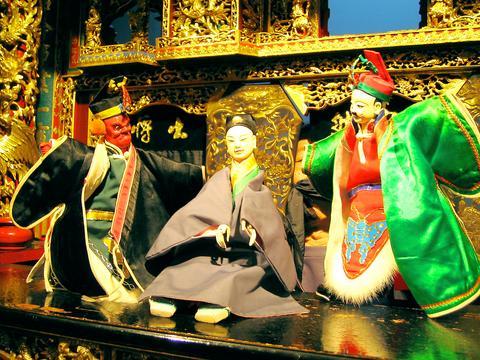The renowned 73 year-old puppet show group I Wan Jan Puppet Theater (
For the first time in more than 70 years, Southern Winds musicians will be performing with puppeteers in the play Guan Yin (Goddess of Mercy) Taking the Five Hundred Lohans (

PHOTO COURTESY OF I WAN JAN PUPPET THEATER
Revered Southern Winds musicians -- who are on average 60 years old, with the oldest 92 years old -- have gathered from the four corners of Taiwan especially for the shows.
"This is going to be an animated and funny adaptation of a traditional repertoire," said Lee Chuan-tsan (
In other words, he said, although the play is about Buddhism, it will be filled with jokes, Chinese drums and gongs, Chinese reed horns and flutes.
I Wan Jan (meaning "really lively") Puppet Theater was founded by master Lee in 1931. He is well-known for his combination of opera music and puppetry, including Northern and Southern Winds and Peking Opera music.
Starting in 1974, Lee began to take students from around the world so he could pass down his traditional art. Taiwanese filmmaker Hou Hsiao-hsien's (侯孝賢) Cannes winning movie The Puppet Master (戲夢人生) is a biography of Lee's life.
Aiming to preserve Lee's heritage, I Wan Jan's style is entirely different from the so-called Ching Guang puppetry (
The stage of golden colored wooden sculptures of dragons has been used since the troupe's founding days.
The story of Guan Yin Taking the Five Hundred Lohans comes from a Buddhist legend. Once there were 500 bandits congregated on the Mountain of Buddha, making a living by robbing civilian households. It was a mob of illiterates and they needed someone to be an accountant to deal with their money. While they were persuading a bookworm to do the job, Guan Yin Buddha was looking from above.
She insisted the bandits were, really, all kind and decided to incarnate as a young woman and play small tricks to influence and reform the bandits. The major drama of the play centers on the tricks and tactics Guan Yin uses to tame the mob and make them Lohans (guards of Buddha).
According to Lee, Southern Winds Puppet Theater is one of the traditional musical forms of puppet performances. Southern Winds and Northern Winds are unique music styles for operas and theater performances in Fukien province, and were later developed in Taiwan. Southern Winds has its specialized music instruments, such as five-pieced bamboo clappers, smaller-sized reed horns and percussion.
Most of I Wan Jan's performances, however, have been accompanied by a mixture of Peking Opera music and Northern Winds, according to Lee. "Mainly because people thought the music was louder and more bustling. Also it has been hard to get together old musicians from the Southern Winds style," Lee said.
To break the stereotype of Southern Winds music, which is thought of as slow and quiet, I Wan Jan recruited 13 musicians to create a loud musical background for the show. Such an assemble doubles the number of puppet show musicians.
To make sure the audience understands the literary jokes, there will be Chinese subtitles beside the stage. Guan Yin Taking Five Hundred Lohans serves as one of the performances of the 2004 Taipei Traditional Arts Festival. It is also seen by Lee as a warm-up to the group's Paris show at the end of the month.
From May 30 to June 8, I Wan Jan will be giving a joint performance of The Monkey King Raids the Celestial Palace (

May 26 to June 1 When the Qing Dynasty first took control over many parts of Taiwan in 1684, it roughly continued the Kingdom of Tungning’s administrative borders (see below), setting up one prefecture and three counties. The actual area of control covered today’s Chiayi, Tainan and Kaohsiung. The administrative center was in Taiwan Prefecture, in today’s Tainan. But as Han settlement expanded and due to rebellions and other international incidents, the administrative units became more complex. By the time Taiwan became a province of the Qing in 1887, there were three prefectures, eleven counties, three subprefectures and one directly-administered prefecture, with

It’s an enormous dome of colorful glass, something between the Sistine Chapel and a Marc Chagall fresco. And yet, it’s just a subway station. Formosa Boulevard is the heart of Kaohsiung’s mass transit system. In metro terms, it’s modest: the only transfer station in a network with just two lines. But it’s a landmark nonetheless: a civic space that serves as much more than a point of transit. On a hot Sunday, the corridors and vast halls are filled with a market selling everything from second-hand clothes to toys and house decorations. It’s just one of the many events the station hosts,

Two moves show Taichung Mayor Lu Shiow-yen (盧秀燕) is gunning for Chinese Nationalist Party (KMT) party chair and the 2028 presidential election. Technically, these are not yet “officially” official, but by the rules of Taiwan politics, she is now on the dance floor. Earlier this month Lu confirmed in an interview in Japan’s Nikkei that she was considering running for KMT chair. This is not new news, but according to reports from her camp she previously was still considering the case for and against running. By choosing a respected, international news outlet, she declared it to the world. While the outside world

Through art and storytelling, La Benida Hui empowers children to become environmental heroes, using everything from SpongeBob to microorganisms to reimagine their relationship with nature. “I tell the students that they have superpowers. It needs to be emphasized that their choices can make a difference,” says Hui, an environmental artist and education specialist. For her second year as Badou Elementary’s artist in residence, Hui leads creative lessons on environmental protection, where students reflect on their relationship with nature and transform beach waste into artworks. Standing in lush green hills overlooking the ocean with land extending into the intertidal zone, the school in Keelung